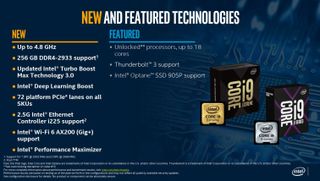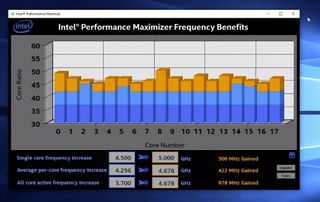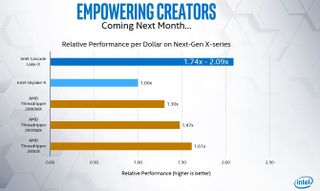Intel Announces Cascade Lake-X With up to 50% Price Cut, More PCIe (Updated)

There's little doubt that AMD's Threadripper lineup has wreaked havoc on Intel's high-end desktop (HEDT) lineup, and with today's Intel Cascade Lake-X announcement we see the impact in sharp relief: Intel has cut pricing of its chips by up to 50% in preparation for AMD's next-gen Threadripper chips. The price cut is also needed to deal with AMD's delayed 16-core 32-thread Ryzen 9 3950X that will land for a mere $750 on mainstream platforms.
The new Cascade Lake-X processors feature higher clock speeds and a new Turbo Boost 3.0 implementation, support more RAM capacity at faster speeds, and bring more PCIe lanes. The chips will be available in November 2019 and also come with some notable technology additions at both the chip and the platform level. Intel has also infused more of its hardware-based security mitigations into the silicon.
Intel 10th-Gen Cascade Lake-X Processor Lineup
| Row 0 - Cell 0 | Cores /Threads | Base / Boost (GHz) | L3 Cache (MB) | PCIe 3.0 | DRAM | TDP | MSRP/RCP | Price Per Core |
| TR 2990WX | 32 / 64 | 3.0 / 4.2 | 64 | 64 (4 to PCH) | Quad DDR4-2933 | 250W | $1799 | $56 |
| TR 2970WX | 24 / 48 | 3.0 / 4.2 | 64 | 64 (4 to PCH) | Quad DDR4-2933 | 250W | $1299 | $54 |
| Core i9-10980XE | 18 / 36 | 3.0 / 4.8 | 24.75 | 48 | Quad DDR4-2933 | 165W | $979 | $54.39 |
| Core i9-9980XE | 18 / 36 | 3.0 / 4.5 | 24.75 | 44 | Quad DDR4-2666 | 165W | $1979 | $110 |
| Core i9-10940X | 14 / 28 | 3.3 / 4.8 | 19.25 | 48 | Quad DDR4-2933 | 165W | $784 | $56 |
| Core i9-9940X | 14 / 28 | 3.3 / 4.5 | 19.25 | 44 | Quad DDR4-2666 | 165W | $1387 | $99 |
| TR 2920X | 12 / 24 | 3.5 / 4.3 | 32 | 64 (4 to PCH) | Quad DDR4-2933 | 180W | $649 | $54 |
| Core i9-10920X | 12 / 24 | 3.5 / 4.8 | 19.25 | 48 | Quad DDR4-2933 | 165W | $689 | $57.41 |
| Core i9-9920X | 12 / 24 | 3.5 / 4.5 | 19.25 | 44 | Quad DDR4-2666 | 165W | $1189 | $99 |
| Core i9-10900X | 10 / 20 | 3.7 / 4.7 | 19.25 | 48 | Quad DDR4-2933 | 165W | $590 | $59 |
| Core i9-9900X | 10 / 20 | 3.5 / 4.5 | 19.25 | 44 | Quad DDR4-2666 | 165W | $989 | $98.9 |
| Core i9-9820X | 10 / 20 | 3.3 / 4.2 | 16.5 | 44 | Quad DDR4-2666 | 165W | $889 | $88.9 |
As before, the Cascade Lake-X chips are based on the Skylake microarchitecture and fabbed on the 14nm process, though Intel isn't divulging which "+" revision it uses for the new chips.
Intel has bumped up clock speeds across the entire range, which results in an expected TDP increase to 165W, and added a new boosting feature that targets up to four cores with its Turbo Boost 3.0 technology, an expansion of the feature that allows it to hit two more cores with lightly-threaded applications. We'll dive deeper into that enhancement shortly.
The reduced pricing pops right off the page. Whereas the 9th-gen processors have an average price-per-core of $103, this will be reduced to ~$57 per core for 10th-gen Cascade Lake-X. The most expensive of the four will be the Core i9-10980XE with 18 cores at 3.0GHz and a TDP of 165W. It has a slightly improved Turbo Boost 2.0 frequency of 4.6GHz and 4.8GHz with Turbo Boost 3.0. But most notably, Intel slashed the price in half to $979, which is even less than the previous-gen Core i9-9900X with 10 cores.
The Core i9-10900XE sits at the bottom with slightly improved base and boost frequencies and will cost $590, which is surprisingly only $30 more than the expected pricing of the Core i9-9900KS for the mainstream desktop. Intel says that it made this drastic price cut on the low end of the HEDT stack to make it easier for customers to step up to the more capable platform with its expanded feature set.
You'll notice that Intel didn't refresh its eight-core 16-thread Core i9-9800X, which makes sense given that the Core i9-9900K offers the same core/thread count on the mainstream desktop. We also don't see a 16-core model to deal with AMD's much-anticipated Ryzen 9 3950X. That might mean Intel has something in store for a later date, as we doubt the company will leave the 3950X uncontested.
Stay on the Cutting Edge
Join the experts who read Tom's Hardware for the inside track on enthusiast PC tech news — and have for over 25 years. We'll send breaking news and in-depth reviews of CPUs, GPUs, AI, maker hardware and more straight to your inbox.
The Cascade Lake-X chips come with 48 PCIe lanes, an increase of four extra lanes compared to the previous-gen models. Intel was able to expose four additional lanes from the HCC die to the socket, and while these chips are compatible with existing X299 boards, you'll likely lose those extra four lanes unless you upgrade to one of the new X-series motherboards that will also debut with the new chips. Intel still remains on PCIe 3.0, a disadvantage compared to AMD's support for PCIe 4.0 that offers twice the I/O bandwidth. AMD also still holds the lead in sheer PCIe lane counts at 60, and the overall core count lead with 32. We expect Intel to address those higher core counts with a refreshed Xeon W lineup.
New Turbo Boost Max 3.0
| Row 0 - Cell 0 | Base Freq. | Turbo Boost 2.0 | All-Core | TB Max 3.0 (Two Fastest Cores) | TB Max 3.0 (Two Next-Fastest Cores) |
| Core i9-10980XE | 3.0 | 4.6 | 3.8 | 4.8 | 4.7 |
| Core i9-9980XE | 3.0 | 4.4 | 3.8 | 4.5 | N/A |
| Core i9-10940X | 3.3 | 4.6 | 4.1 | 4.8 | 4.7 |
| Core i9-10920X | 3.5 | 4.6 | 4.3 | 4.8 | 4.7 |
| Core i9-10900X | 3.7 | 4.5 | 4.3 | 4.7 | 4.6 |
Intel's new Turbo Boost Max 3.0 implementation takes things a step further, targeting the four fastest cores with lightly-threaded apps, as opposed to only targeting two cores with the previous-gen models. However, the frequency for the second two fastest cores drops 100 MHz from the listed Turbo Boost Max 3.0 frequency. This is a smart addition that should help the company build on its per-core performance advantage, and was foreshadowed by an impending Windows scheduler alteration that rotates workloads more efficiently across favored cores (i.e., faster cores) to improve performance and reliability. That feature debuts in Windows with the Windows 10 2H19 update.
Intel 10th-Gen Cascade Lake-X Platform Enhancements
At the platform level, memory support has been improved to DDR4-2933, and the maximum amount of memory capacity has doubled to 256GB. There are also four more PCIe 3.0 lanes, with 72 lanes total if you account for the HSIO lanes carved off the PCH. That gives motherboard vendors more options to deploy support for Wi-Fi 6 and 2.5G Ethernet on the new motherboards designed for these chips.

Intel has also brought support for DL Boost, Intel’s new AI-focused instructions that double or triple the performance of FP16 or INT8 AVX-512 vector code, to the HEDT space. That may sound like an unneeded feature for the high end desktop, but Intel is working with several companies to enable radical performance increases to image enhancement, image tagging, video analysis, and voice recognition programs, all of which also play well to the prosumer crowd. As Intel has indicated in the past, expect performance improvements in these types of workloads to start at 2X relative to previous-gen platforms. Naturally, the improvements will be even more pronounced for customers coming from older systems.
Intel Performance Maximizer

Furthermore, there is support for Intel’s auto-overclocking Performance Maximizer software, and Intel tells us that Cascade Lake-X will support the new per-core overclocking feature when the software receives a new update. The existing software is already impressive and even programs AVX offsets during the auto-overclocking process, which is important given Cascade Lake-X's prosumer focus. The addition of per-core overclocking will be a powerful feature to wring the most out of the silicon.

Thoughts
AMD's Threadripper has caused Intel considerable pain on the high end desktop, and the pending 16-core 32-thread Ryzen 9 3950X only exacerbates the issue, especially given that it slots into price-friendly mainstream motherboards. AMD also has its next-gen Threadripper lineup in the works, which should bring even lower per-core pricing to the table, so it's clear Intel had to react.
Intel's biggest advantage during this assault has simply been its incumbency, especially in the workstation and prosumer markets where reliability and "knowns" are often more important than price. But AMD has radically altered the price-to-performance ratio and has more in store with its next lineup of chips.
There's a tipping point where incumbency can no longer outweigh value, which Intel acknowledged with a recent presentation at IFA.

Intel presented this slide at the event. The slide teases us with today's news that the company would slash pricing, with claims of up to 1.74x to 2.09x increases in the price-to-performance ratio for Cascade Lake-X, but the real message in this chart is a bit more subtle.
Intel acknowledges here that the price-to-performance ratio of its existing Skylake-X lineup is inferior to AMD's Threadripper processors, which is a shocking admission when those are the best products Intel has on the shelves. Brand equity is powerful, and one of Intel's key advantages that comes as a byproduct of a decade of dominance. Intel's admission that the competition has a better value proposition is unheard of, but delivers the message that the company knows it has to become more competitive.
And that it has. These gen-on-gen price reductions are unprecedented for Intel, but they also have the side effect of radically devaluing previous-gen chips, which is something Intel typically avoids. There's no doubt that Intel's silicon has historically held its resale value much better than AMD's, largely because each new lineup of AMD chips foreshadows massive price cuts on previous-gen models. With a price war forming, it appears that Intel is now willing to take more risks with devaluing its previous-gen models.
But the story isn't over. AMD has a full cadre of new Threadripper chips coming, now purportedly split into both workstation and prosumer models and platforms, much like Intel's Xeon W and Cascade Lake-X lineups. That opens up a new angle of attack on Xeon W, Intel's new high-margin profit generator that has thus far been unchallenged.
That's sure to intensify what is now a price war between the two companies. We can't wait to see how it unfolds, especially as Comet Lake approaches.
-
mdd1963 I'd be more than a little irked if I'd just paid $1900+ for a 9980XE anytime within the last several months....; that is an even worse case of 'buy at the wrong time-syndrome' than when the 6950X ($1799+) was replaced by the 7900X ($999) 18-20 months ago...Reply -
kinggremlin Reply
Oh well. The tech industry has been like this since its beginning. Just another example of unnecessarily dwelling on the negative. Complain when prices are too high. Then complain when prices that were too high are dropped.mdd1963 said:I'd be more than a little irked if I'd just paid $1900+ for a 9980XE anytime within the last several months....; that is an even worse case of 'buy at the wrong time-syndrome' than when the 6950X ($1799+) was replaced by the 7900X ($999) 18-20 months ago... -
GetSmart These new Intel CPUs can only compete with AMD's mainstream Ryzen desktop CPUs, and certainly not against AMD's current Threadripper HEDT CPUs because still lagged behind in term of maximum core counts and the number of PCI Express lanes. To challenge AMD's current Threadripper HEDT CPUs, at least those Intel workstation class Xeons. Additionally that Intel Core i9-10900X could make the current Intel Core i9-9900K's position kinda precarious. Update: Anandtech's article also mentions similar scenario about Intel Core i9-10900X and Intel Core i9-9900K.Reply -
GetSmart Years ago, Intel's HEDT is a niche segment. How many can afford any Intel CPUs with 8 cores and above? Nowadays high core count CPUs are no longer a niche anymore. Times have changed.Reply -
InvalidError Reply
In terms of core count per dollar or dollars per core, the new Intel CPUs are perfectly fine compared to current prices on TR2 CPUs. The PCIe lane count argument may have been a big thing back when Intel's HEDT started at only 28 PCIe lanes but at 48 lanes, I doubt it is even a remote concern to most potential buyers.GetSmart said:These new Intel CPUs can only compete with AMD's mainstream Ryzen desktop CPUs, and certainly not against AMD's current Threadripper HEDT CPUs because still lagged behind in term of maximum core counts and the number of PCI Express lanes. -
Murissokah Kudos to AMD for bringing back competition. The last decade has been disappointing in terms of CPU innovation.Reply -
InvalidError Reply
Don't celebrate too soon, prices are still trending up for a given relative performance tier in the mainstream instead of trending down (rather sharply at that) as they used to back when we had price wars between AMD and Intel every year until ~12 years ago.Murissokah said:Kudos to AMD for bringing back competition. The last decade has been disappointing in terms of CPU innovation.
I'm not going to declare victory for consumers until I see AMD and Intel trying to one-up each other for domination at every price point instead of releasing the bare minimum they can get away with for a given product cycle.
I'm glad that AMD finally put a check on Intel's greed, not so pleased with AMD getting greedier while Intel is at a disadvantage. -
FurryVengence All I do on my rig is play games, those CPU prices are STILL way to rich for my blood. I'll save that money and use on a better GPUReply -
MasterE I noticed that the AMD Threadripper 2950X was conspicuously missing from the comparison table... I guess because for an article talking up the Intel processor lines coming, no one wanted too many AMD processors pushing out the intended Intel "supremacy" announcements.Reply
Says the man running an Intel Core i7 4790K but secretly wanting a TR 2990WX
Most Popular



